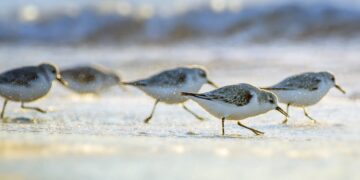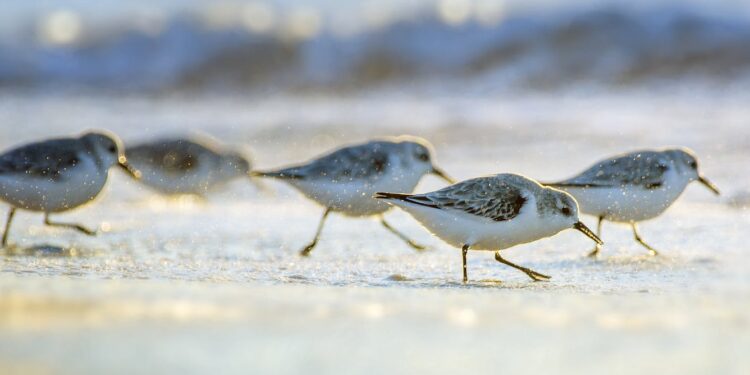Login to Continue Learning
As I walked along Bolivar Flats, just across from Galveston Island in Texas, I watched flocks of sanderlings forage along the frothy wavefront as it surged and retreated. Nearby, Casian terns, American avocets, and black skimmers rested on the beach, each in its own group.
The birds rose simultaneously as I drew near, then settled farther down the beach, clearly fearing me.
As an evolutionary biologist and author of “The Social Lives of Birds,” I’m fascinated by how social behavior has evolved in birds. Why do they flock together when competition for food might pass on diseases or even lead to infidelity?
Safety in numbers
In 1971, Oxford University biologist William D. Hamilton discussed the advantages of flocking in his landmark paper “Geometry for the Selfish Herd.” He theorized that individuals stay in a group because each benefits from the shelter it provides. At the time, a prevailing belief was that animals moved in groups to benefit the group, not the individual.
Groups provide safety by being harder to attack, more likely to warn of approaching danger, and capable of responding together if threatened. But everyone doesn’t benefit equally; the best position is one where another bird acts as a shield between oneself and a predator.
The peril of being the lone bird
Shorebirds like those I saw in Texas might be the easiest to study, particularly where predators come from forests that border the shore.
One of the best-studied flocking shorebirds is the common redshank (Tringa tetanus), often seen feeding on mudflats and saltmarshes in Britain. Redshanks are sandpipers very closely related to the greater and lesser yellowlegs I see in Texas, but with red legs rather than yellow.
The predator that redshanks most fear is the Eurasian sparrowhawk (Accipiter nisus), which watches foraging birds from trees bordering the saltmarsh. When a sparrowhawk picks its prey, it flies fast and hard toward a single target, grabbing the hapless redshank with its talons.
Evolutionary biologist Will Cresswell studied the redshank’s flocking behavior on the Tyninghame Estuary and found that sparrowhawks were most successful in catching lone birds and those in smaller flocks. The closer a bird was to a neighbor, the less likely it was to be targeted and caught.
Large flocks have downsides too
One downside of being in a large redshank flock is increased competition for food. With other flock members probing the sand and the invertebrates fleeing this probing, the redshanks spend more time foraging when they are in larger flocks.
Canadian ornithologist Guy Beauchamp compared closely related species on islands with fewer predators to those on the mainland where predators were common. Flocks were smaller on islands, allowing birds to forage with less competition.
Fantastic flying flocks
Flying in flocks can also help birds avoid predators. Evolutionary biologist Daniel Sankey and his colleagues used an artificial predator, a robot falcon, to study pigeon behavior. When the pigeons noticed the robot falcon, they turned sharply away, following their nearest neighbor’s direction and did not cluster more tightly.
More spectacular but harder to study are the mesmerizing flocks of European starlings as they circle and swerve, avoiding predators before settling for the night. These flocks of thousands are called murmurations and are fantastic to watch; likely frustrating for predators that would struggle to grab a single bird from the swirling scene.
Beyond flocks: Roosts and supersociality
Birds are social in other ways too. Some sleep together in roosts, nest near each other in colonies, or show off together, carrying out mating dances known as lekking to attract females. They may actively help each other in rearing the young, typically if they are related to the breeders, or anticipate inheriting the breeding position or territory.
Take time to watch the behavior of the birds around you, and you’ll start to notice social behaviors everywhere, from the ducks in a city pond to the chickadees hunting for insects deep in winter. I hope you’ll watch them with more understanding of their social lives and with a little bit more wonder.



















